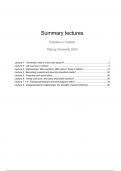Summary
Summary Families in Context lectures UVT 2024
- Course
- Institution
Summary of all the lectures of Families in Context (FiC) at Tilburg University given in 2024 by prof. Ivanova. The summary is fully in English and additional tips and exam questions mentioned by the lecturer are added. I also have a summary on my account with all the literture for this course. Thes...
[Show more]



